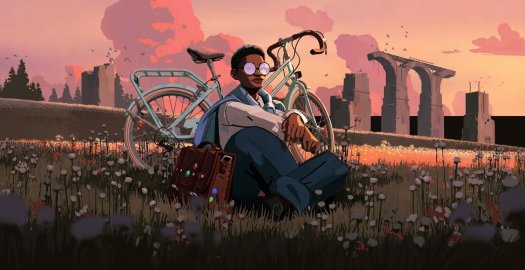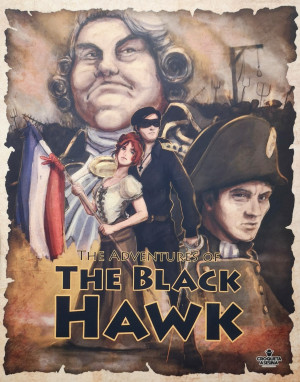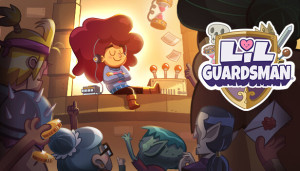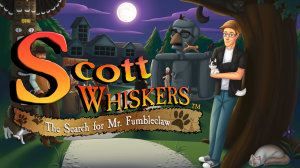Review for Season: A Letter to the Future

Usually when I am reviewing a game, I make a few notes as I go along, but rarely do I feel the need to write more than a page. In the case of Season: A Letter to the Future, however, I wrote three full pages of notes. This is not to say that this is a particularly complex game in terms of its gameplay; in fact it’s rather simple. The point is that it is so full of carefully considered philosophy and wisdom that I found myself making notes for my own pleasure, with my own future in mind. The philosophical worldview that the game presents – which seems to be drawn from many aspects of Asian culture – is central to the themes of the game and the choices that you must make as you go on this strange, pre-apocalyptic journey.
The main character, known as the Protagonist, lives in a village called Caro high up in the hills of a world not unlike our own. Dreams are given particular importance in this world: we are told, “Sleep is the shadow life that unites us all”. So, following a friend’s prophetic dream that a great change is on the way, the Protagonist embarks upon a journey down into the neighbouring Tieng Valley to document what is referred to as the “end of the season”. Two conditions apply to their going on this potentially dangerous journey: their mother has asked that they wear a pendant containing protective memories at all times, and the village elder has requested that any findings be documented in a journal to be submitted to a museum vault at the edge of the world.
It is this documentation of the Tieng Valley that forms the bulk of the gameplay in Season: A Letter to the Future. Whilst many games (from Life is Strange to Red Dead Redemption II) will keep a journal for the player as they progress, here you have to put one together yourself. Each time you visit a new location of importance, you start a new journal page and have to fill each one with information. For most locations you are free to arrange and collage the assembled information in any layout you wish. If you enjoy design work this offers you a chance to make attractive presentations; if you don’t enjoy it then you can just place the items down in any order. For the more important locations you must follow a template layout to ensure you collect all the relevant information about each place.
Objects that catch your attention as you travel around (denoted by a hand symbol) should be investigated, but you are also free to take photographs of whatever you want, and record any of the sounds you hear. You have a Polaroid camera and a small tape machine with a microphone with which to record the world, and it’s a fun process – realistic enough without being too time-consuming. Often the Protagonist will comment wisely on the photographs and sound recordings after you take them, no matter your skills – as you are sagely informed, “There are no mistakes, only wayward inspiration”!
You also make pencil sketches, write short passages of text and collect items such as leaflets or scraps of paper, although the player has less control over these processes as they occur automatically after interacting with certain objects or scenes. You will meet other characters on your journey, and encounter a number of quite strange phenomena in certain locations. Everything you see and hear can be recorded and in this way a picture of life in the Tieng Valley and what is happening there slowly emerges.
I found this whole process quite enjoyable, if sometimes repetitive in its sheer scale, and I have to admit it will not suit every player. There is no need to be creative with your page layouts, but there is a need to be fairly methodical with the retrieval of the information. I spent about six hours on this game but feel there was much that I missed, despite making perhaps 50 double pages of journal. The story develops slowly and organically as you look at what emerges from your investigations. Although I discerned enough of a sense of free will to prevent this from being termed a ‘walking simulator’, for many there could simply be too much reading / listening and not enough action.
There is one other gameplay feature of note, however: cycling. The Protagonist has a bicycle and cycling down those long empty roads into the valley (there is no other traffic) is a lot of fun. The bicycle handles very nicely and fairly realistically: you can freewheel down hills and have to stand up to start pedalling uphill. At one stage you can request to be taken on a bike tour of the major valley locations with a character who lives there.
The only issue I had with the cycling was that I felt I kept having to interrupt this very enjoyable aspect of the gameplay to stop and record important information. In actuality, I think there was no need to stop at the earliest opportunity but that it was just my mindset to complete the game within as efficient a time frame as possible. I really could and should have spent more time just enjoying the view from the saddle!
And the view really is stunning at times. The Tieng Valley is one of the more beautiful and intelligently realised computer landscapes I have encountered recently, with derelict temples, empty buildings, frozen figures and gigantic statues. It reminded me sometimes of the 2016 puzzle game The Witness, in its lusciously colourful and strangely static beauty. I think there are also many more varied visual influences, from certain Impressionist paintings to the films of Studio Ghibli (particularly Spirited Away). Even if you don’t care for the influences, this is undeniably a gorgeous looking game.
What jarred visually were some of the supporting characters. Although the Protagonist is a rather elegant and appealing looking character, at least to my eyes, many of the other characters seem to be from completely different games from another era of computing. Their whole design and scale just look wrong and actually broke my – otherwise very strong – sense of immersion in the world at times.
The gender and background of The Protagonist seem to have been made partially indeterminate to diminish the influence of these factors on the game (whilst retaining the sense of being a real person). I didn’t find this approach brought much to how I engaged with the story, however, as the Protagonist is clearly a young person and seems to be mostly defined by this youthfulness. However, I was pleased to see a character at least a little different to the expected norm. Maybe this is also the intention with the incongruous set of supporting characters – that we should not judge a place by the way its people look, or vice versa – but if so I’m not convinced this has been successfully executed in that regard.
Where graphically some of the characters did not impress me, there is strong voice acting in evidence from all of them. I was particularly moved by the self-reflective monologues of the valley’s solitary artist, Matyora. One of the task-related puzzles involves helping her select a few examples from her body of work to be preserved in your journal. She is voiced with a sense of gravitas and real artistic authenticity; the voice acting convincingly demonstrates her self-understanding of the importance of her work.
The greater part of the sonic palette consists of the voice acting, with atmospheric environmental sounds making up the background. There is scant music to be heard, although there is a very nice a cappella song performed during a showreel presentation in a dig site.
Season: A Letter to the Future managed to sustain my interest throughout, due to its combination of an interesting plot with an impressive depth of philosophical insight – insight both into the events that are unfolding in the valley and on a more personal level for the young Protagonist. However, I found parts of the game slightly repetitive – particularly recording all those sounds for the journal – although this was largely compensated for by a nice sense of freedom to the process and the order in which the journal can be compiled. One thing that did occur to me on completion of the game, is that it would be good to have a feature to be able to look through the journals created by other players, as each one is likely to be quite different. Although perhaps difficult to achieve cross-platform, in my opinion this would have lifted the game, maybe even another notch in its score.


























